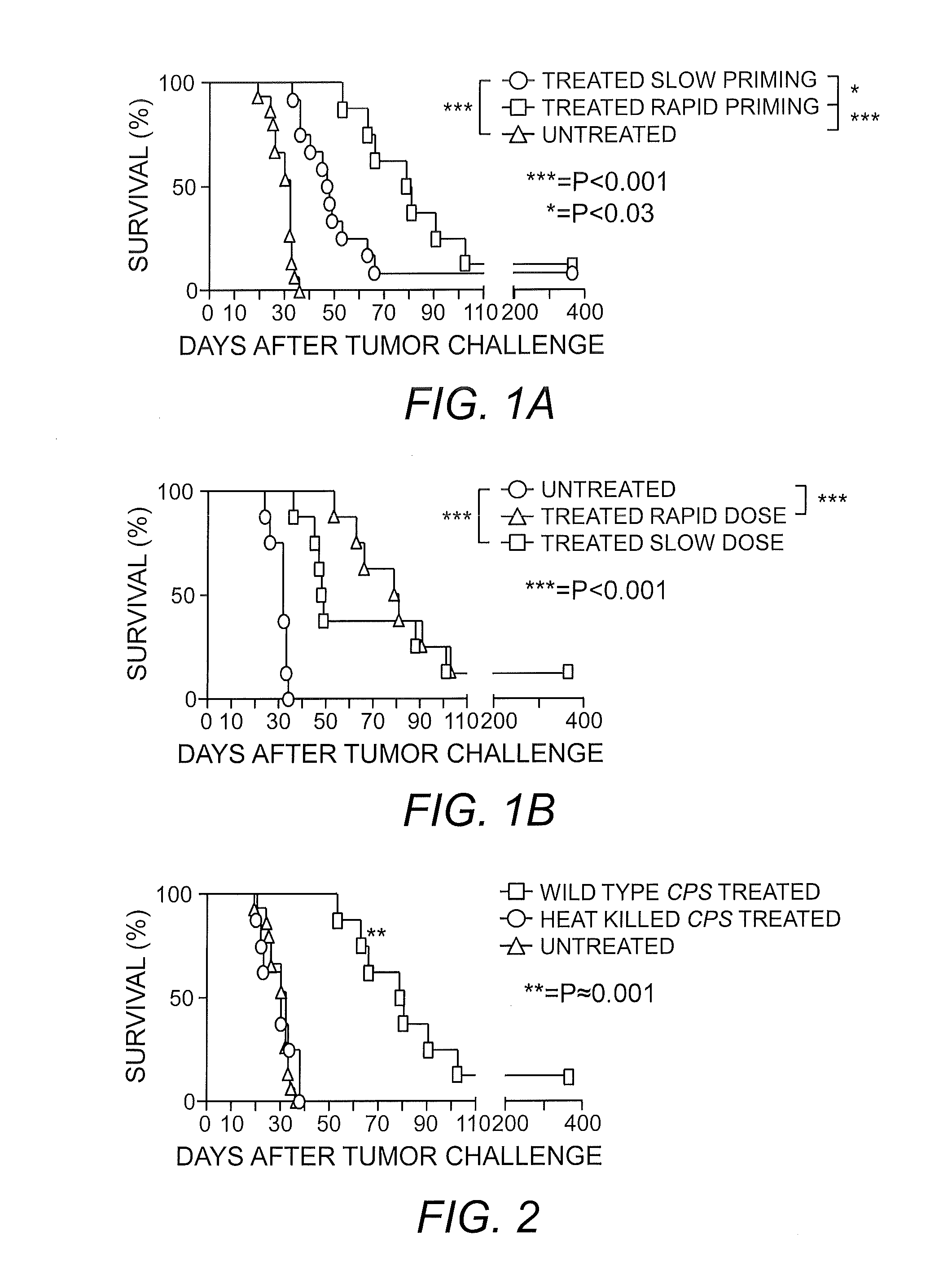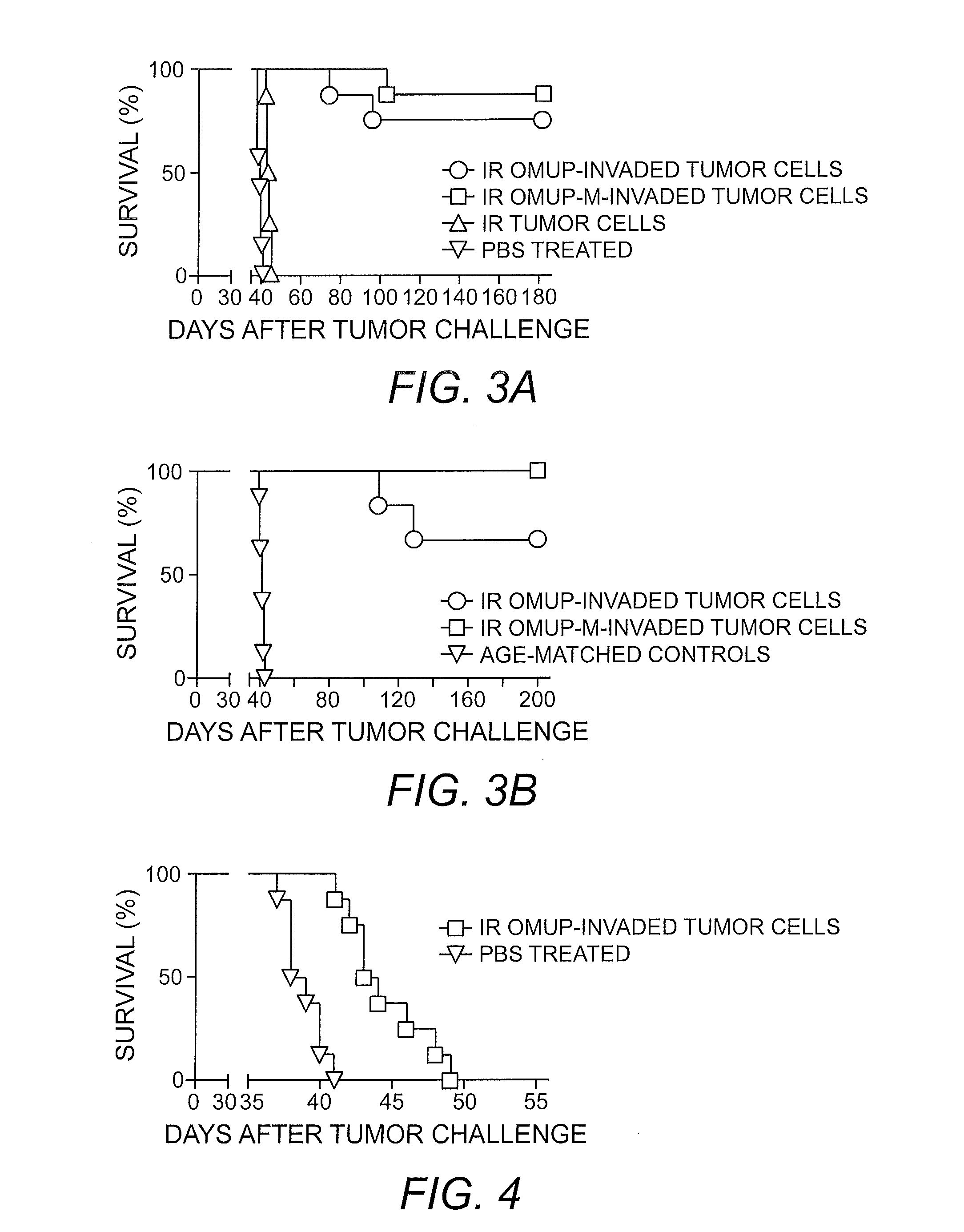Method for treating pancreatic cancer with toxoplasma gondii vaccine
a technology of toxoplasma gondii and pancreatic cancer, which is applied in the direction of antibodies, ligases, lyase, etc., can solve the problems of untreatable tumor essentially quickly returning in untreatable form, ineffective antitumor t cell responses mediated by cd4 and cd8 t-cells, and tumors that are immune-suppressed
- Summary
- Abstract
- Description
- Claims
- Application Information
AI Technical Summary
Benefits of technology
Problems solved by technology
Method used
Image
Examples
example 1
Materials and Methods
[0032]Parasites.
[0033]Toxoplasma gondii RH strain or attenuated uracil auxotroph mutants OMUP (Δku80ΔompdcΔup::HXGPRT) or cpsl (CPS mutant) have been described (Fox & Bzik (2002) Nature 415(6874):926-9; Fox & Bzik (2010) Infect. Immun. 78:3744-52) and were cultured according to known methods (Fox & Bzik (2002) supra). In some experiments, tachyzoites were further inactivated by γ-irradiation (15 krad).
[0034]Mice.
[0035]6-8 week old C57BL / 6, IL-12p35− / −, IFN-γ− / −, MyD88− / −, and CD8a− / − were purchased from Jackson Laboratory.
[0036]Cell Lines.
[0037]The murine pancreatic adenocarcinoma (Pan02) cell line was acquired from the Division of Cancer Treatment Tumor Repository (National Cancer Institute). Pan02 cells were maintained in high glucose RPMI supplemented with 10% fetal bovine serum (FBS) and penicillin / streptomycin. ID8-GFP cells were maintained in high glucose DMEM supplemented with 10% FBS and penicillin / streptomycin. Human foreskin fibroblasts (HFF) cultures ...
example 2
Treatment with Live Attenuated T. gondii Increases Survival in Mice with Intraperitoneally Disseminated Pancreatic Cancer Tumor
[0051]To examine the efficacy of CPS and OMUP mutants in aggressive pancreatic cancer, mice were injected intraperitoneally (i.p.) with Pan02 cells to simulate late-stage metastatic disease progression (Wennier, et al. (2012) Mol. Ther. 20:759-768). Mice were treated with CPS, OMUP or given control PBS and survival was tracked. Treatment with CPS (FIG. 1A) or OMUP (FIG. 1B) resulted in increased survival of mice exposed to pancreatic cancer. To further analyze treatment, the doses of CPS and OMUP mutants administered were increased. While there was a delay in the onset of metastatic disease, long term, there was still a 15-20% long-term survival rate between slow dose and rapid dose treatments (FIGS. 1A and 1B).
[0052]It has been demonstrated that T. gondii unable to actively invade does not elicit the same responses as live T. gondii (Goldszmid, et al. (2009...
example 3
T. gondii Mutant Treatment Increases Myeloid Cells and Triggers Activation of these Populations
[0053]To examine alterations in the cellular composition of the tumor microenvironment, Pan02 tumors were established and subsequently treated 14 days post-tumor inoculation with OMUP. The composition of the local microenvironment was then analyzed on days 1, 2, 4, 7 and 10 post-treatment. Following OMUP treatment, local B cells were reduced within 18 hours and continued to decline up to 10 days post-treatment. This population of cells has been implicated in promoting tumor progression by secreting pro-tumorigenic cytokines involved in skewing Th1 and Th2 immunity (Joyce & Pollard (2009) Nat. Rev. Cancer 9:239-252; Gabrilovich, et al. (2012) Nat. Rev. Immunol. 12:253-268).
[0054]Treatment with OMUP also increased the population of dendritic cells and this population increased up to 4 days post-treatment with numbers fully declined by day 10. Interestingly, macrophage populations sharply dec...
PUM
| Property | Measurement | Unit |
|---|---|---|
| time | aaaaa | aaaaa |
| temperature | aaaaa | aaaaa |
| cure rate | aaaaa | aaaaa |
Abstract
Description
Claims
Application Information
 Login to View More
Login to View More - R&D
- Intellectual Property
- Life Sciences
- Materials
- Tech Scout
- Unparalleled Data Quality
- Higher Quality Content
- 60% Fewer Hallucinations
Browse by: Latest US Patents, China's latest patents, Technical Efficacy Thesaurus, Application Domain, Technology Topic, Popular Technical Reports.
© 2025 PatSnap. All rights reserved.Legal|Privacy policy|Modern Slavery Act Transparency Statement|Sitemap|About US| Contact US: help@patsnap.com


